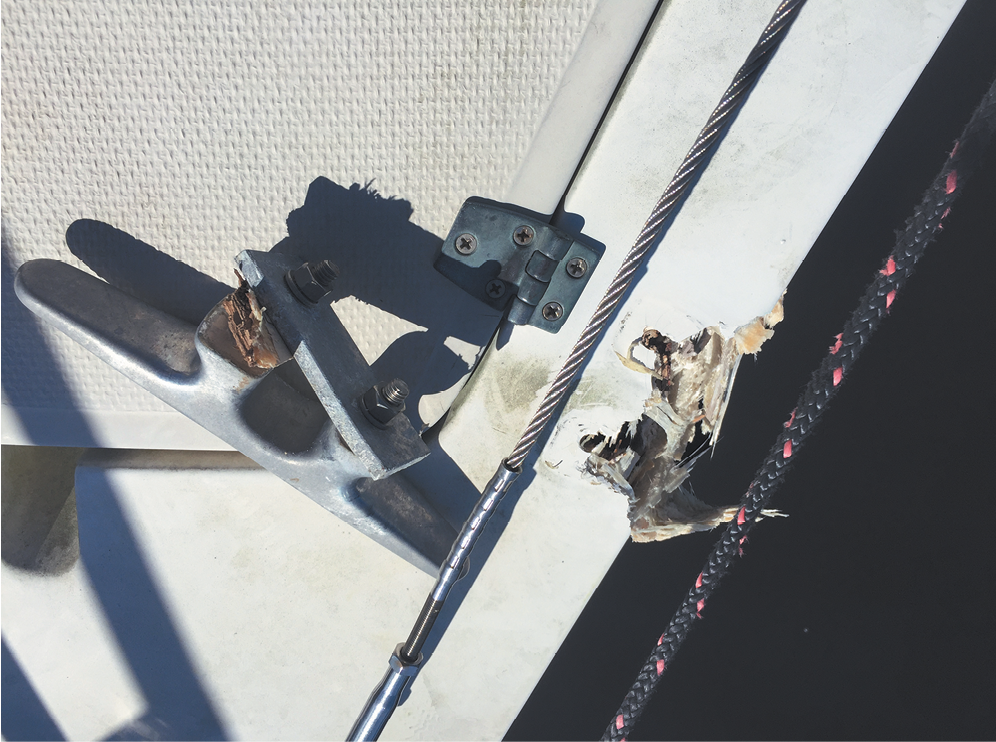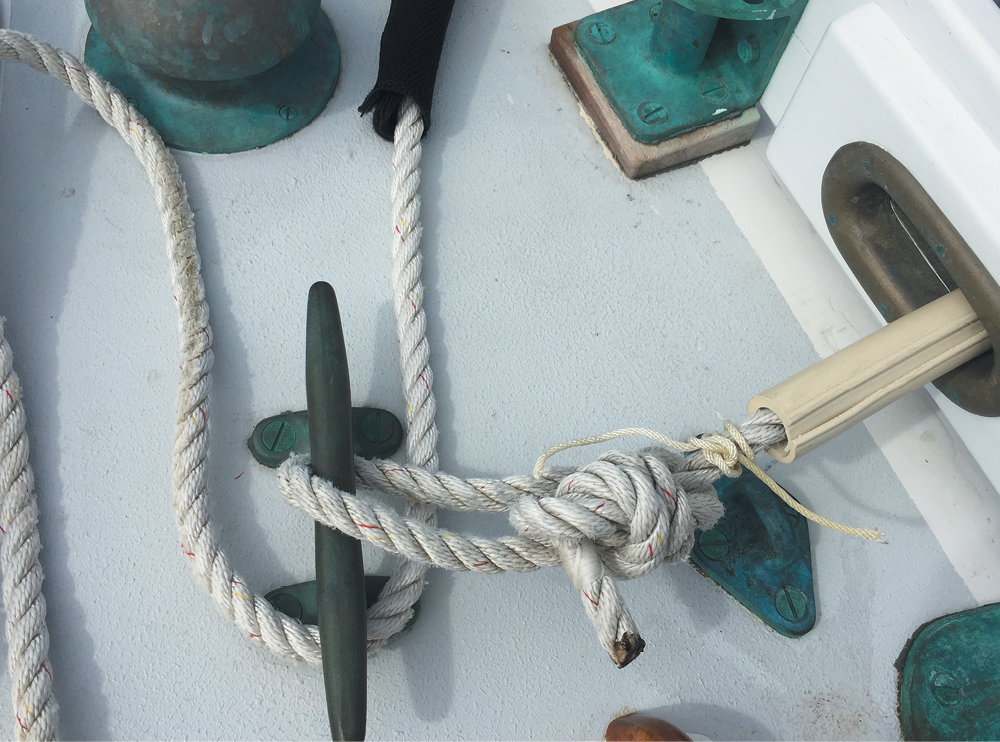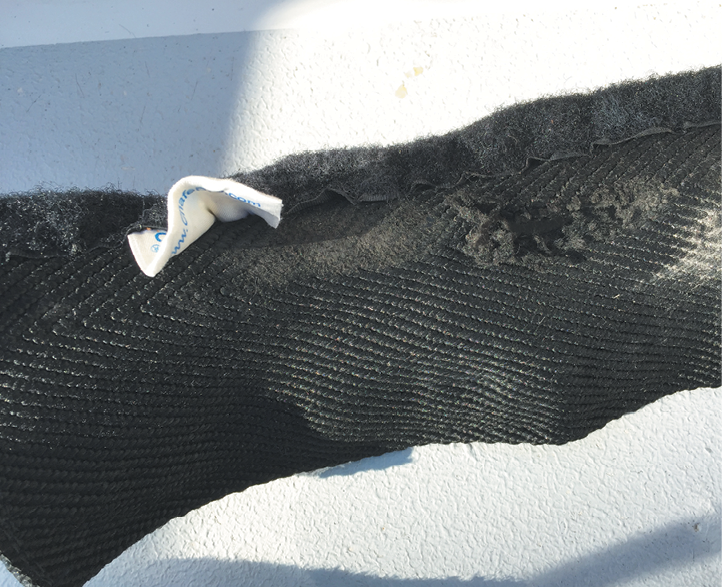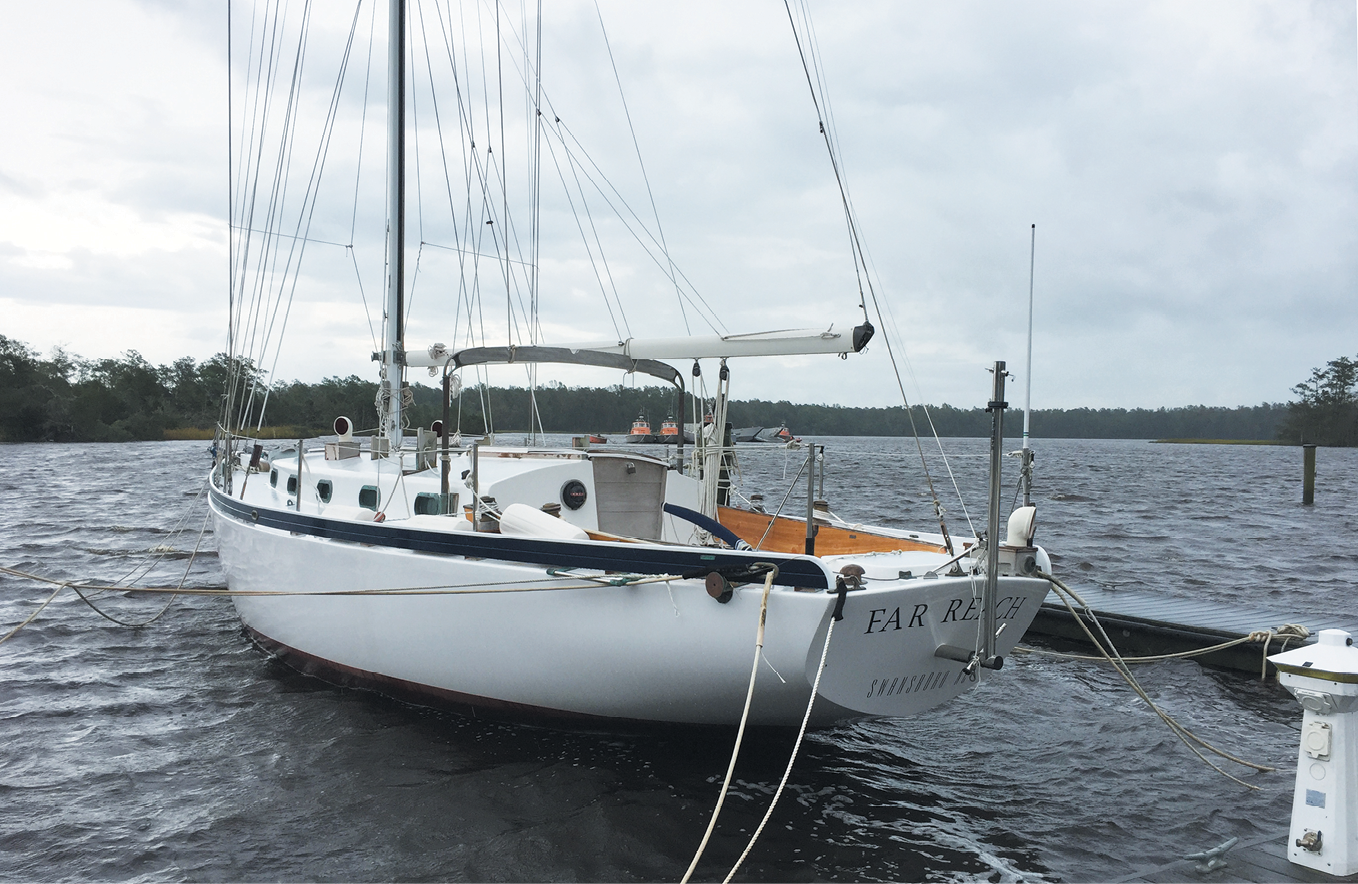August through October are hurricane months in the Carolinas. While it’s almost always best to haul out for a hurricane, it’s not an option for every boat owner. In the summer of 2018, our only viable option for securing our 36-foot Cape Dory Far Reach was to remain in our marina slip and get ready best we could.
Our marina is on the Neuse River about 20 miles from where it empties into Pamlico Sound, a large body of water between the mainland and the famous Outer Banks of North Carolina. Our marina has 360 degrees of protection. The docks are fixed (non-floating), recently rebuilt, and in good shape. The marina did not require evacuation because it is one of the best hurricane holes in the area.
Every June, my wife and I discuss our plan for the upcoming hurricane season. Our plan in 2018 was to keep Far Reach in the marina. We limited our travel plans during September or October so we could be present and prepare the boat if a hurricane threatened our area.

Before the hurricane season began, we made one of the most important decisions we could have made—we chose to put the Far Reach in one of two empty 26-foot-wide catamaran slips. While other boat owners considered the wide slip as inconvenient, I believed the extra space would help Far Reach better survive a storm.
9 SEPTEMBER—STORM ALERT
Hurricane Florence was in the news. She was making a beeline for the US with early projections for a landfall on the southeast coast. We began planning for its arrival. The first thing we did was turn Far Reach around in her wide slip, so her bow was facing northeast toward the longest fetch and predicted wind direction.

keeping the boat centered fore-and-aft in its slip as water rises.
We removed sails, canvas, solar panel and cleared the decks. I removed the bowsprit’s sprit-shroud stays so they wouldn’t chafe the bow lines. Far Reach was practically empty.
10 SEPTEMBER—3 DAYS TO PREPARE
The forecast was dire. Florence had grown to a Category 4 hurricane. The most powerful winds would be coming from the NE and E, driving the water into Pamlico Sound and up the Neuse River. The early surge forecast would prove to be very accurate—9 to 13 feet.

We expected the hurricane force winds and heavy rain would knock down trees and, along with flood waters, block the roads in our area. We made a reservation at a military hotel on the Marine Corps base where our marina is located. We felt it was important to be able to check lines during the surge and address any concerns until the last possible moment. We also wanted to be able to take in slack on the lines after the hurricane passed and the surge dropped, to keep the boat from hitting the dock.
12 SEPTEMBER—SECURING DOCK LINES
Our everyday dock lines for the Far Reach (16,000 pounds) are high quality ½-inch nylon three-strand New England Ropes. Allowing plenty of stretch and easy to inspect, three-strand lines are my preference for this duty. The lines were in good shape, but I wanted to double all the dock lines for added strength and to provide redundancy should a line break or chafe through.

For the second set of lines, I cut 250 feet of ¾-inch double braid nylon anchor line into four lines of about 50 feet and two lines 25 feet in length. To protect them, I had about a half dozen of the old-style rubber Taylor Made chafe guards and another half dozen Chafe-Pro guards (see “Chafe Protection for Fiber Rodes,” PS October 2019).
We added those six additional ¾-inch double braid lines, and two more 3-strand lines to our everyday eight ½-inch bow, stern, and spring lines for a total of 16 dock lines. All were long enough to accommodate the surge we expected. We added chafe guards to the lines to prevent lines from chafing through on deck chocks or hawse holes.
The fixed docks are normally about 4.5 feet above the water. With a predicted 9- to 13-foot surge, the water could rise 5 to 9 feet over the top of the dock. Our wide slip gave us an important advantage when setting dock lines to compensate for this surge.

We centered the Far Reach in the slip. We gave the lines plenty of slack—enough that she could float up without breaking the lines. The stern spring lines were the linchpin for the rest of the lines. With the winds expected from the front, we set the aft spring lines so they would prevent her from drifting over the dock and into the slip behind her.
The forward spring lines were left very loose because I was not concerned if the boat moved forward toward open water. Finally, I added bow and stern lines. There were no breast lines since these would be too short to deal with the surge.

We terminated the lines on the boat and made them adjustable on the dock. We limited the number of lines per cleat to two. One line passed through the center of the cleat with a bowline and an extra overhand knot in the tail for safety. The second line was cleated normally with an additional half-hitch in the tail to keep it from slipping loose.
The dock had fixed pilings on each outboard end. We secured the bow lines and the aft spring lines to the pilings with rolling hitches. We then took the tails around the piling one more time and tied the ends off to the standing part with half hitches.
We had no choice but to tie the stern lines and forward springs to the dock cleats. As we did with the boat cleats, we knotted the tails with a half hitch for extra measure.

Finally, I created a chest-high safety line along the dock using our secondary anchor rode. This would give me something to hold onto if the dock was underwater.
13 SEPTEMBER—LAST DAY TO PREP
The day before Florence arrived, we loaded up our truck with a cooler, ice, food, water, flashlights, raingear, life jackets, coils of lines, tools, binoculars, and a handheld VHF radio. We moved into our hotel room. By 11 a.m. on 13 September the water was just over the dock. By 2 p.m. the water was about 18 inches over the dock. I made my way out to the boat and added slack to the lines.
We returned at 6 p.m. to make another adjustment, but there was four feet of fast-moving water over the dock, and the wind was too strong for us to do more. I said a prayer for Far Reach and returned to the hotel room.
It was a long night. The boat I spent six years building and had safely carried me to and from the West Indies was having the trial of her life.
14 SEPTEMBER—FLORENCE MAKES LANDFALL
Shortly before landfall, Hurricane Florence had subsided to Category 1 storm, with winds of about 105 mph. She was moving very slowly, causing terrific wind damage and flooding. By 10:30 a.m., the eye was past our longitude. The storm had not made landfall, but I felt it was safe to go to the marina.
The road to the marina was blocked with downed trees. We parked the truck, grabbed our gear, and started hiking to the boat. The wind was still blowing about 45 knots.
The marina was a disaster. Peering through my binoculars, I could see at least four boats had sunk, all over 34 feet in length. Five boats had been driven up on land. One boat was missing entirely.
Still searching through the binoculars, I strained to see Far Reach. Nothing. My heart sank. Then, peering hard through the horizontal rain, I suddenly recognized her mast. She was afloat and looked to be centered in her slip. We made our way down to the parking lot, still under a foot or more of water. I donned my life jacket and worked my way out along the flooded dock using the safety line we rigged the day before.
The destruction was shocking. Every boat on our dock had been damaged. An Islander 37, a slip away from Far Reach, had sunk. One 30-footer had floated over the top of its pilings and landed alongside another 30-footer in its slip. Both boats were severely damaged.
As I approached Far Reach, it was apparent she was unharmed. We estimate the marina had 10 to 12 feet of surge and winds over 80 mph. With the surge rapidly falling, I snugged the lines to ensure the boat would not bang against the docks.
My wife Gayle and I took refuge at the clubhouse until the winds dropped later that afternoon. We were the only boat owners present. The water level and wind speed were dropping fast. As soon as it was safe, we began to secure loose boats and take in slack on dock-lines to prevent further damage to as many boats as we could.
We pushed boats off pilings and recentered them in their slips the best we could. By the next morning many owners had arrived. We all worked together to restore some order to the marina. There was minimal damage to the robustly constructed docks, but the number of sunk and damaged boats was stunning.
LESSONS LEARNED
Many of the lessons we learned will ring familiar to sailors who live in a hurricane zone, but they bear repeating. I am convinced the reason Far Reach survived without damage was because we’d followed proven techniques.
Marina action plan. A marina should have a written posted storm action plan available to every boat owner. Email it. Attach it to the contract. Put it on the website. Send it out at the start of hurricane season. Hold a meeting before a hurricane. Open an email dialogue with boat owners as soon as a storm looks like a threat. Our marina did not have one.
Proactive dockmaster. The value of a proactive, knowledgeable dockmaster cannot be overstated. The dockmaster should have the knowledge and tools he needs to communicate with all owners (especially absentee owners), and to prevent storm damage as much as possible. One marina in our area has a volunteer hurricane strike team, under the supervision of the dockmaster, to ensure boats are properly secured in the days leading up to the storm.
Doubled-up lines. Use adequately sized lines, doubled up and with chafe guards. Boat cleats should be well backed. Lines should be adjustable from the dock since you likely will not be able to access the deck of the boat.
Reduced windage. Strip the boat. Many boats were not stripped and still had headsails on furlers, mainsail covers, and Bimini tops rigged.
Safer slip. Use the best slips available to you, even if you must move.
Smart forecast. Analyze how the wind and surge will affect your marina. Plan for it. Position the boat accordingly.
Good connections. Develop a relationship with adjacent boat owners. Share contact info. Formulate plans together. Helping your neighbor helps protect your boat.
Safe access. Having safe access to your boat before, during, and immediately after a storm can be the difference between no damage and a lot of damage.
CONCLUSION
While hauling your boat out is probably the best option, it’s not always possible. Our boat survived a large, powerful hurricane in a marina with fixed piers, one of the last places you’d want to be during a storm like Florence, bringing with it a high, long-lasting surge. With forethought, an understanding of how the storm will affect your marina, planning, hard work, an active marina staff, an amazing partner, and a little luck, your boat can survive one too.







































